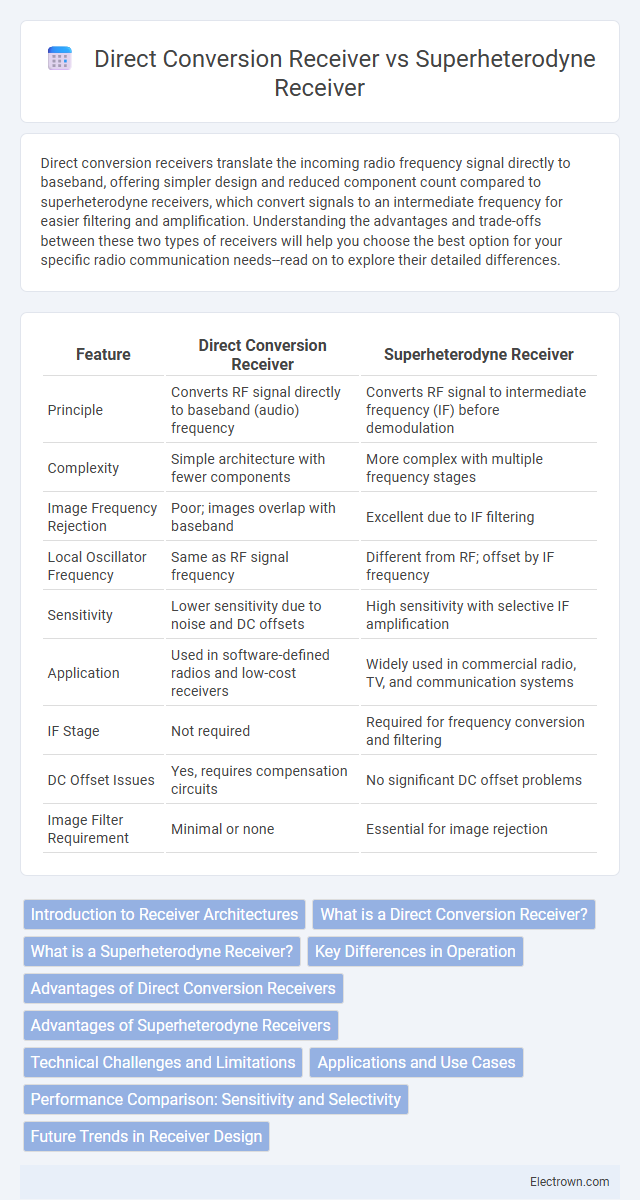Direct conversion receivers translate the incoming radio frequency signal directly to baseband, offering simpler design and reduced component count compared to superheterodyne receivers, which convert signals to an intermediate frequency for easier filtering and amplification. Understanding the advantages and trade-offs between these two types of receivers will help you choose the best option for your specific radio communication needs--read on to explore their detailed differences.
Table of Comparison
| Feature | Direct Conversion Receiver | Superheterodyne Receiver |
|---|---|---|
| Principle | Converts RF signal directly to baseband (audio) frequency | Converts RF signal to intermediate frequency (IF) before demodulation |
| Complexity | Simple architecture with fewer components | More complex with multiple frequency stages |
| Image Frequency Rejection | Poor; images overlap with baseband | Excellent due to IF filtering |
| Local Oscillator Frequency | Same as RF signal frequency | Different from RF; offset by IF frequency |
| Sensitivity | Lower sensitivity due to noise and DC offsets | High sensitivity with selective IF amplification |
| Application | Used in software-defined radios and low-cost receivers | Widely used in commercial radio, TV, and communication systems |
| IF Stage | Not required | Required for frequency conversion and filtering |
| DC Offset Issues | Yes, requires compensation circuits | No significant DC offset problems |
| Image Filter Requirement | Minimal or none | Essential for image rejection |
Introduction to Receiver Architectures
Direct conversion receivers convert incoming radio frequency signals directly to baseband without intermediate frequency stages, simplifying circuitry and reducing component count. Superheterodyne receivers use frequency mixing to convert signals to one or more intermediate frequencies, enhancing selectivity and sensitivity through well-established filtering techniques. Your choice between these architectures depends on factors like complexity, performance requirements, and application environment.
What is a Direct Conversion Receiver?
A Direct Conversion Receiver, also known as a zero-IF receiver, directly converts the received radio frequency (RF) signal to baseband without an intermediate frequency stage, simplifying the design and reducing component count. This type of receiver uses a mixer that directly translates the RF signal to audio or data signals by mixing it with a local oscillator at the same frequency as the carrier. Advantages include lower power consumption and reduced image frequency issues compared to Superheterodyne Receivers, though it may face challenges with DC offset and flicker noise.
What is a Superheterodyne Receiver?
A Superheterodyne Receiver is a radio receiver that converts the received signal to a fixed intermediate frequency (IF) to simplify filtering and amplification, enhancing selectivity and sensitivity. It uses a local oscillator and mixer to shift the frequency, allowing precise tuning and improved performance over varying signal strengths. Your ability to receive clearer, more stable signals depends on this frequency conversion process, making it a fundamental technology in modern radio communications.
Key Differences in Operation
Direct conversion receivers demodulate the incoming radio frequency signal directly to baseband without intermediate frequency stages, enhancing simplicity and reducing component count. Superheterodyne receivers convert the input signal to one or more intermediate frequencies using mixers and local oscillators, improving selectivity and sensitivity through efficient filtering. Your choice between these architectures impacts receiver design complexity, performance in signal isolation, and susceptibility to image frequency interference.
Advantages of Direct Conversion Receivers
Direct conversion receivers offer simpler architecture with fewer components, leading to reduced size, cost, and power consumption compared to superheterodyne receivers. They provide improved phase noise performance and direct demodulation of the baseband signal, enhancing signal fidelity in digital communication systems. The elimination of intermediate frequency stages minimizes image frequency problems and simplifies filtering requirements.
Advantages of Superheterodyne Receivers
Superheterodyne receivers offer superior selectivity and sensitivity by converting incoming signals to a fixed intermediate frequency, enabling easier and more precise filtering and amplification. This design reduces image frequency interference and improves overall signal clarity, making it ideal for complex or weak signal environments. Your communication system benefits from enhanced performance and reliability due to the robust frequency conversion process characteristic of superheterodyne receivers.
Technical Challenges and Limitations
Direct Conversion Receivers face challenges such as DC offset, I/Q imbalance, and LO leakage, which can degrade signal quality and require complex calibration. Superheterodyne Receivers, while providing better selectivity and sensitivity, are limited by image frequency interference and require multiple frequency conversions, increasing circuit complexity and power consumption. Both architectures demand careful design trade-offs to optimize performance for specific applications and frequency ranges.
Applications and Use Cases
Direct conversion receivers excel in software-defined radios and low-power wireless devices due to their simpler architecture and reduced component count, which allows for compact, cost-effective designs. Superheterodyne receivers dominate in commercial broadcast, military communications, and radar systems, offering superior selectivity and sensitivity through frequency mixing and intermediate frequency stages. Your choice depends on whether your application prioritizes integration and power efficiency or advanced filtering and signal clarity.
Performance Comparison: Sensitivity and Selectivity
Direct conversion receivers offer enhanced sensitivity by directly converting RF signals to baseband, reducing noise figure and simplifying circuitry. Superheterodyne receivers generally provide superior selectivity with multiple intermediate frequency (IF) stages and high-Q filters that effectively reject adjacent channel interference. Sensitivity in superheterodyne designs is typically balanced against increased complexity and cost, while direct conversion excels in compact, low-power applications where high integration is essential.
Future Trends in Receiver Design
Future trends in receiver design emphasize software-defined radio capabilities, with Direct Conversion Receivers gaining popularity due to their simplified architecture and lower power consumption. Superheterodyne Receivers continue evolving, integrating advanced filtering and digital signal processing to enhance selectivity and sensitivity. Your choice in receiver technology will increasingly depend on balancing system complexity, performance requirements, and adaptability to emerging wireless standards.
Direct Conversion Receiver vs Superheterodyne Receiver Infographic

 electrown.com
electrown.com